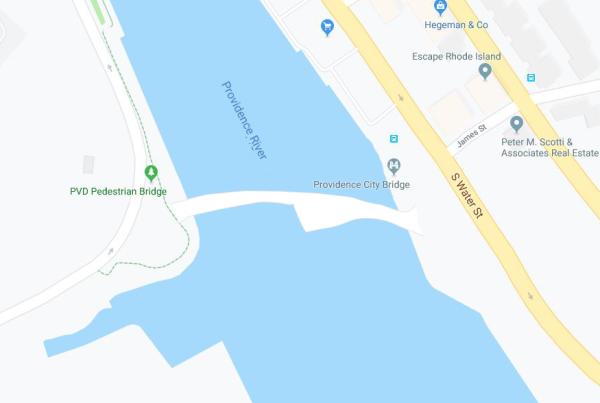The Michael S. Van Leesten Memorial Bridge, also known as the Providence River Pedestrian Bridge, connects the city's Fox Point neighborhood on the East Side to the burgeoning Innovation & Design District.
Opened in August 2019, this pedestrian bridge reuses the existing piers of the old I-195 highway bridge. Stretching 450 feet across the Providence River, the deck of the bridge is constructed from Brazilian Ipe wood and features matching wooden benches, built-in chess boards, and illuminated tables. At the end of each side of the bridge are sprawling urban parks often featuring pop-up vendors, entertainment and food trucks.

You'll find restaurants on the east side of the river, including Hemenway's, Dave's Coffee, Bacaro, Geoff's Superlative Sandwiches and Plant City, along with shops all along South Main Street. Stroll the area at your own pace with our East Side Historic Walking Tour Map.
On the west side of the bridge is a larger park area with seasonal pop-up vendors and The Guild's PVD Beer Garden, in operation from late spring through early fall. Blu Violet, the rooftop bar atop the Aloft Providence Downtown, offers incredible views of the East Side and the waterfront while serving up small bites and masterfully crafted cocktails. Dune Brothers Seafood and Bayberry Garden feature patio dining and favorite New England dishes. In the summer, be sure to stop by the Providence Flea in 195 District Park most Sundays. There's also plenty of history to explore throughout the Jewelry District, much of which is covered in our Jewelry District Historic Walking Tour Map.
Bridge Location:
The west side of the bridge is accessible from Dyer St. near Ship St. The east side of the bridge is accessible from South Water St. near James St.

Insta-Worthy
The bridge has quickly become one of the best spots in the city to take pictures. Check out these awesome photos from Instagram:
Jewelry District Historic Walking Tour
How did Providence, Rhode Island become the “Jewelry Capital of the World”? The first steps by Nehemiah Dodge and Jabez Gorham in the late 18th century happened outside of the Jewelry District, but set the pace for what was to come. Jewelry made in Providence was going to be affordable, mass produced and based on innovative technologies, particularly electro-plating. After the Civil War, most of the state’s jewelry manufacturing moved into the Jewelry District south of downtown.
East Side Historic Walking Tour
Walk timeworn streets and chart the city's growth on foot with this historic walking tour.


